#shonen with women project
Explore tagged Tumblr posts
Text
I think the other thing about Shonen with Women is like. It's more than simply writing Shonen with a female lead, or with multiple female characters. Because all those things already exist. We have Soul Eater. We have JoJo part 6. We have the Cutie Honey animes. We have Korra. But like, that's not necessarily what people say they want when they say they want Shonen with Women.
They say they want Shonen, but please tone down the ecchi/heavy sexualisation (which Soul Eater and Cutie Honey are guilty of). They mean Shonen, but focused on female characters from the start (JoJo and Korra are both continuations of older stories). Shonen, but better than what is already done, basically. Shonen, but it addresses the misogyny and effectively turns away from that. Shonen as escapism, but escaping to something better.
And I feel like that's why this type of thing will only really meaningfully happen in indie projects? Because like, we've been through this multiple times already. I just don't think the television networks and comic companies and toy companies who overwhelmingly are the ones producing media under the Shonen umbrella are going to produce media with women doing cool action hero things in that sort of tone. At least, not in large amounts. Not consistently. Not enough such that there is a SWW for everyone.
Someday I hope that there is enough things such that Sturgeon's Law can meaningfully kick in. That there are a fairly large number of things in the top 10% of works such that people can spend their lives happily engaging with those things. But that's only going to happen if more people make it. And sure, most people who make it will end up mostly as the 90% of work that isn't very good. It's worth the effort still, I think.
8 notes
·
View notes
Text
Yeah, I think this aspect of the difference in these stories is a manifestation of gender roles in different forms of storytelling too. Men and boys are also expected to be “active” and take initiative in ways that women and girls aren’t typically. (Sorry to use tvtropes-speak as an example, but I believe the trope is “Men Act, Women Are”?)
I also recall this thing I read in a book once which made this observation that a lot of magical girl fiction takes place within a very “domestic” setting. As in, the story tends to take place in a handful of familiar settings most of the time, typically in the main character’s home city. Travelling to other planets or realms may happen, but it overwhelmingly takes place in a familiar location, and is about protecting the one location.
Whereas a lot of shonen, while the protagonist’s hometown might be of great importance to him, he does spend a lot more time going out and exploring the world. Meeting new and different enemies. The hero makes a name for himself in different places and establishes himself.
Obviously individual series will differ (to my knowledge most of My Hero Academia takes place in one city for example). But it is interesting to think about as far as a pattern in media goes. One type of hero is seen as a domestic guardian, while the other is a trailblazing upstart. For a magical girl to be a little closer to a Shonen hero, she might have to be able to find it in her to set her childhood home on fire.
Adding onto the differences between shonen and magical girls, I think one of the more notable ones to me is that a lot of shonen protagonists are more agentic and proactive on average.
They are more likely to have some kind of ambition that they train and learn in order to pursue. This is, for many of them, an important source of power just as critical to their success as their ability to throw 85 punches per second (which is sometimes treated as something anyone could do if they trained hard enough anyway).
Meanwhile, a lot of magical girl stuff (even shows I like) involves the characters simply being granted power from the beginning by some supernatural patron or item, sometimes as a reward for virtue or inherent specialness.
Their power is something given to them rather than something they must cultivate through their efforts but ultimately own.
I know there's exceptions on both sides, of course. Naruto, for example, is kind of infamous for having all sorts of blessings bestowed upon him for existing. This is more of a general observation than a hard rule.
Anyway, I think the first type of power appeals to me far more. It has more of a "self-modify into your ideal self and take control your own destiny" sort of vibe that I personally really like and I think it would be cool if more female characters got to have that.
195 notes
·
View notes
Text
ray is genderfluid because imagine the euphoria of confining yourself to a box your whole life because you’re so afraid to discover things about yourself only to have it all taken away and then escaping and being allowed to explore those things and realizing you can just be anything you want at anytime, you’re finally free. emma is agender because ray’s hogging all the genders and he won’t share
#skye's ramblings#yes the genderfluid ray is projection have you met me. but it also fits really well you see. i'm right#okay but in seriousness. agender emma is so so very real to me. reject gender entirely emma would not care about it <3#i say it a lot but the female protagonist literally never being shown in a skirt after escaping the heavily regulated environment#-that she grew up in is so so dear to me. emma is just so important to me like. in general <3#tbh t/pns portrayal of gender presentation and firm rejection of gender roles in general is just. really fucking good#especially for a shonen like!! why cant you all love women and diverse presentation this much. why cant you be more like your brother
10 notes
·
View notes
Text
Hello, everyone! It’s International Women’s Day and to celebrate, I’d love to share some of the best female Linkers of Project Link Up!
Have lots of fun, and slay, ladies!
#international women's month#international women's day#livi’s rambles#project link up#Shonen jump power linkage#Genshin impact elemental linkage#super smash bros power linkage#have fun!!
5 notes
·
View notes
Note
I think I might have asked before, but what exactly are One Piece's problems? I know about the wonky anatomy of the female characters and the time Oda defended a pedo, but what are the other issues?
ok, first of all i dont want us to brush over the atrocious female anatomy in display because it is really that fucking egregious and almost dealbreaking on its own. this is the one true proof we need that just "practisce" is worthless as an artist, the guy has been drawing women every day for 20 years and he has just gotten worse at it. there are also some more subtle forms of sexism in the story like how many women are captains in the story (i think like.... uhhhh.... two??? and one of them is this big fat giant ugly hag villain, the other is a child who for plot reasons has the body of a super sexy 20 something year old and the sexy clothes to match but she is a child) and other details here and there that are a bit too subtle for me to really want to go into.
so that aside, is just kind of a death of a thousand cuts. the cast is too bloated and after a while they just become irrelevant, the time decompression is brutal and things that should be resolved in one issue will take ten, after a while the fights just become boring and uninspired, the way luffy defeats every villain is just that he punches them like really really hard.
i want to harken back to the characters because honestly the interactions between the main characters are basically non existant. how does franky feel about tony, for example? how about the dynamic between usopp and, say, brook? tony has basically not been a character since before the time skip. everyone has become a very simplified version of themselves until an arc shows up where we now can explore another interesting facet of this character but that happening is so far inbetween that it becomes incredibly tedious to read.
is just tedious in general, is so big and bloated and over the top and slooooow that its just hard to care anymore. there are a hundred things happening in the background but nothing is really happening on a chapter to chapter basis. and the characters have stopped being really characters a long while ago.
luffy is kind of a thoughtless brute that does what he wants without asking permission or saying sorry and conquers everything by sheer bravado and punching really hard and he always has that dumb cocky smile with him, there is this general glorification of brute strength and being the biggest most awesome badass who rolls over everything by sheer confidence and force of will, (but you cant be mean about it because that is bad) there is this idea that you can just "project force" (or haki*) and the rest of the world just kind of bows to that. its very shonen, is my point, in the teenage sort of immature awesome cool anime way that gets hard to stomach after a while, it starts feeling really dumb. its a thousand chapters of that.
*also haki is just really stupid in general. the gum gum fruits provided a lot of cool interesting power dynamics and problem solving to fights but now you can just use haki which is this vague idea of how confident/determined/sheer presence you have and the characters can just arbitrarily have however much they need in order to win a fight and it always trumps fruit devil powers and is just like who fucking cares except children who are so excited that luffy reached super sayin level over 9000 or whatever
18 notes
·
View notes
Text
Shoujo Manga’s Golden Decade (Part 1)
Shoujo manga, comics for girls, played a pivotal role in shaping Japanese girls' culture, and its dynamic evolution mirrors the prevailing trends and aspirations of the era. For many, this genre peaked in the 1970s. But why?

Manga stands as one of Japan's primary cultural exports, deeply ingrained in the local culture and enjoyed by individuals of all ages and genders across various genres. Conventionally, manga is divided into two editorial segments: shonen (targeted at boys) and shoujo (targeted at girls). While shonen manga, propelled by hits like "Dragon Ball," "Slam Dunk," "Naruto," and "One Piece," has achieved global popularity, girls' comics, with their own international sensations such as "Sailor Moon," hold a crucial position in the market. The evolving landscape of girls' manga serves as a fascinating lens through which to observe the shifting fashionable aspirations and beauty ideals within Japanese society.
Shoujo manga has a rich history, dating back to the early 20th century. However, it truly gained recognition in its modern form in the late '50s and early '60s when prominent Japanese publishers introduced shoujo manga anthologies such as Kodansha's Nakayoshi and Shoujo Friend, as well as Shueisha's Ribon and Margaret. The acclaimed "godfather of manga," Osamu Tezuka, is often credited with creating the first modern shoujo, "The Princess Knight," in 1954, and the first shonen, "Astro Boy," in 1952.
A distinguishing feature of shoujo manga is that it is created by and for girls. But, in the '50s, this wasn't the case, and male artists dominated the shoujo field, which was considered an entryway to the manga business. By the 1960s, that would change as publishers recognized that women creators possessed a unique proficiency in crafting narratives centered around female experiences. Female manga-kas resonated with readers in a way that many male artists couldn't, marking a crucial shift in the landscape of shoujo manga.
The Volleyball Craze
A notable display of how shoujo could mirror societal trends unfolded in the '60s. In 1964, the Tokyo Olympics marked a new beginning for post-war Japan, and the female volleyball team, known as Toyo no Majou (the Oriental Witches), achieved stardom by clinching victory in the finals against the Soviet Republic. This triumph triggered a nationwide "volleyball boom," resonating particularly within the shoujo manga realm.
Shueisha's Ribon, historically the leader in the shoujo manga field, started publication in 1955. Still, the editorial house would only begin to make its series available in standalone tankobon format almost 15 years later through the now iconic Ribon Mascot Comics imprint. The first series to be made available by the imprint was Chikako Ide's "Viva Volleyball."
Simultaneously, over at Kodansha, Shoujo Friend was also eager to capitalize on the boom. Editors commissioned a title about the sport from illustrator Akira Mochizuki and novelist Shiro Jimbo. The final project, "Sign wa V," became a multimedia success, being quickly adapted into a live-action TV drama that achieved very high ratings.
While "Viva! Volleyball" and "Sign wa V" enjoyed success in their time, they did not etch themselves into the collective memory. The true shoujo sports manga blockbuster, a cross-generational classic universally known in Japan, is Chikako Urano's "Attack No. 1," serialized from 1968 to 1970 in Weekly Margaret.

It became the first shoujo manga title to surpass ten tankobon volumes (it had a total of 12 volumes), and it was forever immortalized thanks to its 1970 anime adaptation, which achieved high ratings on Japanese TV. Everything about "Attack No. 1"—from the original manga to the cartoon adaptation to the anime's theme song, which sold over 700k copies as a single—was a success.
The story of a high school girl trying to become the best player in her school, Japan, and eventually, the world became a phenomenon, setting the stage for the '70s "golden era of shoujo."
The Shoujo Lost Years
Until the '70s, manga carried the stigma of being a guilty pleasure, often viewed as a "poison" meant to dumb down young readers. Despite a few discerning individuals recognizing the medium's potential, manga critics, enthusiasts, and tastemakers — predominantly men — largely disregarded female-centric comics. Shoujo manga, despite its immense popularity, faced the harshest criticism.
Because society and critics downplayed shoujo, influential shoujo manga-kas from the '50s and '60s, such as Hideko Mizuno, do not enjoy the same level of recognition as their shonen counterparts from that era.
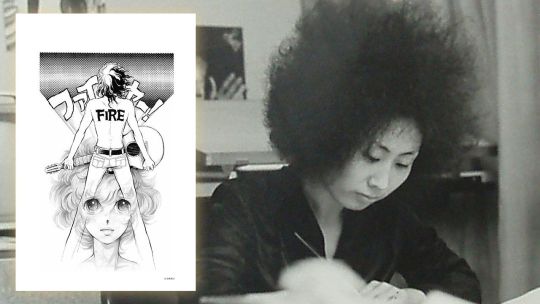
Hideko Mizuno and a page of one of her most celebrated works, "Fire."
Mizuno was one of the first women to create manga, worked as an assistant to Osamu Tezuka, and was behind several massive hits that had a significant impact on women in the '50s, '60s, and '70s. In fact, the most iconic shoujo manga-kas from the '70s golden period directly mention her as an influence. She fought to include romance -- now the essential element in girls' manga -- in her works back when such topics were deemed inappropriate by male editors.
Mizuno's repertoire was vast: she wrote mangas about little girls and their poneys, magic adventures, and romcoms based on Audrey Hepburn's movies, and she drew the first sex scene in a shoujo manga. The manga in question was "Fire," a teen-targeted manga featuring a rebellious American rocker, which broke new ground by having a male character as its focal point. Alongside other notable female artists from the '60s, Mizuno laid the groundwork for the '70s shoujo explosion, during which girls' comics took center stage.
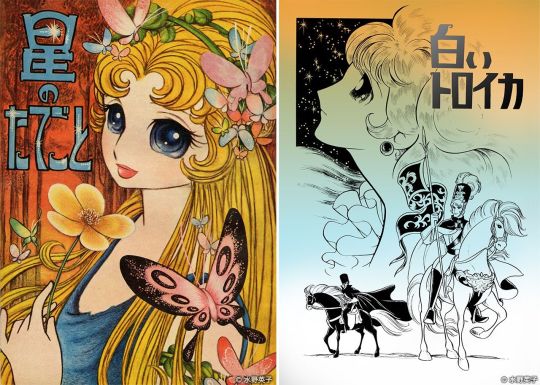
In 1960's "Hoshi no Tategoto" (left,) Hideko Mizuno created the first shoujo love story. Serialized in Weekly Margaret between 1964 and 65, "Shiroi Troika," set during the Russian Revolution, was the first historical shoujo manga.
A contributing factor to this "golden period" was the emergence of several shoujo mangas as unstoppable hits, selling millions of copies and becoming cultural phenomena. These titles, considered masterpieces, continue to be read and known by multiple generations.
The BeruBara Boom
"Attack No. 1"'s success spread far and wide, forcing Japanese society to take note of the potential of the shoujo segment. Right after this historic success, Shueisha's Weekly Margaret hit the jackpot once again with another epoch-defining manga hit, Ryoko Ikeda's "The Rose of Versailles," which debuted in 1972. Set in the years preceding and during the French Revolution, it weaved together historical figures like Marie Antoinette and fictional ones, like the iconic Lady Oscar, a handsome noblewoman raised as a boy to succeed her father as the commander of the Royal Guard at the Palace of Versailles.

The first volume of the original comic had Marie Antoinette on the cover as Margaret's editors believed she'd be the favorite character. However, the androgynous Lady Oscar turned into a fan fave and the absolute star of the series, which is reflected on the cover of most rereleases since then, including the 2013 bunko version seen above.
When talking about shoujo manga classics from the '70s that are familiar to everyone in Japan, "Rose of Versailles" is probably the first name that comes to mind. It was a hit that really defined the era and impacted the country as a whole. While Marie Antoinette is seen around the world as a tragic, out-of-touch figure, in Japan, many women and girls see her as an aspirational historical fashion icon. While Sofia Coppola's 2006 film "Marie Antoinette" solidified this among younger generations, it was Ikeda's gentle portrait that made her a character loved by so many across all age groups.
When conceptualizing the story, Ikeda was heavily inspired by Stefan Zweig's "Marie Antoinette: The Portrait of an Average Woman," which she read while in high school. Once in college, in the late '60s, she, like millions of others, was heavily involved with the Marxist student movements. These references led to a historical romance that touched on heavy and revolutionary themes, which was atypical for a shoujo manga, a segment that, back then, was primarily catered to elementary school-aged girls.
Because of its unorthodox concept, Margaret's editors were unsure about the series. But right from the start, "BeruBara" (derived from the original Japanese title, "Berusaiyu no Bara"), serialized between 1972 and 1973, was an explosive hit, quickly turning into Weekly Margaret's most popular series. It was compiled in 10 tankobon volumes published, which sold tens of millions of copies. In fact, according to some stats, it is the best-selling '70s manga across all genres in total sales.
In 1974, after the original manga had finished its serialization, Takarazuka Revue, an all-female theatrical troupe, announced a stage adaptation of the story.

Posters of the first three Takarazuka adaptations, from between 1974 and 1975. Since then, the Revue has adapted the manga 11 times, with a new run scheduled for 2024.
The Revue was established in 1913 by the owner of Kansai's leading railway company, Hankyu, to boost tourism to the city of Takarazuka, his line's last stop. It was a huge success, and soon, the group had its own luxurious theater as well as its very exclusive academy where young ladies underwent an arduous audition process to become Takaraziennes. In 1934, a second Takarazuka theater opened in Tokyo.
However, in the early 1970s, Takarazuka faced stagnation, with declining ticket sales attributed to the growing popularity of alternative entertainment forms such as cinema and television.
In 1973, Shinji Ueda, who had risen through the Takarazuka ranks as a director, made his debut as a playwriter in the company with a musical based on ancient Japanese history. While thinking about his next project, he decided to check out a manga popular with some Takarazuka fans, "Rose of Versailles," and he quickly realized it was the perfect theme for an adaptation. Lady Oscar, who had lady-like features but was also as handsome as a man, was the embodiment of the male role-playing Takaraziennes. Ueda reached out to Ryoko Ikeda, who, as an admirer of the troupe, quickly granted the rights.
But Ikeda and Ueda's excitement wasn't shared by many. Most of the Takarazuka team were skeptical about a play inspired by something as vulgar as a manga. Fans of the original were also highly protective of its characters and entirely against a live adaptation.
Amid this climate of distrust, the play opened at the end of August 1974 at the Takarazuka Grand Theater. The reaction after the first night was extremely positive. Soon, Takarazuka's "Rose of Versailles" was the hottest ticket in all of Japan, with the press breathlessly covering the "BeruBara boom" that led thousands of people to stand hours in line to get tickets to the coveted performances in Kansai and Tokyo. Ikeda herself was shocked by the media phenomenon when she returned from an overseas trip and had hundreds of reporters awaiting her at the airport.
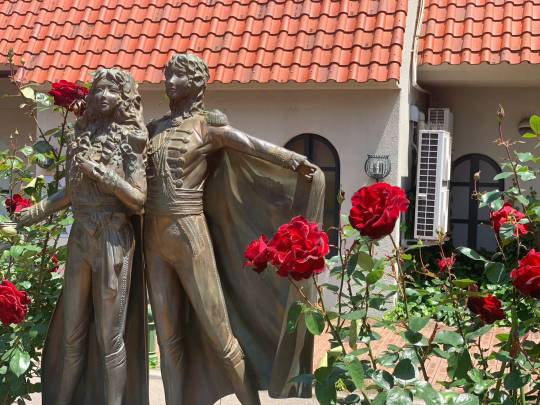
A statue of Lady Oscar and Andre surrounded by rose bushes sits outside the Takarazuka Grand Theater in Hyogo, Japan.
The "BeruBara" media sensation single-handedly reversed Takarazuka's fortunes, leading to record-shattering ticket sales for the company. The Takarazuka Academy, which had seen declining applicants, suddenly became highly sought-after again, originating the saying "Todai in the East, Takarazuka in the West," comparing it to Tokyo University, the most prestigious university in Japan. The phrase underscored the desirability and prestige associated with a position at the troupe.
Ultimately, the success of "The Rose of Versailles" propelled Takarazuka back to the pinnacle of the entertainment industry, a position it maintains to this day. The brand continues to hold great esteem among women of all ages in Japan, with Takarazuka's stage adaptations, derived from Broadway musicals, movies, novels, and shoujo manga, consistently selling out. Notably, various adaptations of "BeruBara" have collectively sold over 5 million tickets since 1974.
Following the manga and Takarazuka adaptation's explosive success, the anime debuted in 1979. While the anime received acclaim, Ikeda herself was not entirely satisfied, mainly due to the treatment of her favorite character, Andre, who played a significant role in the manga but had a minor presence in the animated version, which focused almost entirely on the manga's most popular character, Lady Oscar.

In 2013, celebrating Margaret's 50th anniversary, new special chapters of "BeruBara" were published. The first new story in 40 years resulted in Margaret magazine selling out across the country.
"BeruBara" remains a prominent franchise in Japan, spawning numerous licensed products, sequels, and spin-offs. Ryoko Ikeda, known for other successful series, continues to garner widespread respect and media attention. However, while almost everything related to "The Rose of Versailles" turned into a hit, there was an exception.
In March 1979, a few months before the anime premiere, a live-action film adaptation debuted with great fanfare. Fittingly for such a hot property, the movie was one of the most ambitious productions in Japanese cinema, with a substantial 1 billion yen budget.
The Palace of Versailles granted permission to shoot in its interior. The filming was in English, with a European cast. The project was helmed by France's hottest movie director, Jacques Demy. Demy wasn't respected only in the West but also in Japan, where his two most important films, "The Umbrellas of Cherbourg" (1964) and "The Young Girls of Rochefort (1967)," were also hits. In fact, to this day, both flicks remain popular among trend-conscious Japanese as examples of stylish oshare movies that fully capture aspirational girls' culture (alongside, among others, Sofia Coppola's "Marie Antoinette"). Demy, the mind behind dreamy, girly movies, seemed like the perfect choice to turn this blockbuster shoujo classic into a live-action film.
The movie had the backing of three gigantic domestic corporations: Toho, the leading Japanese movie distributor; Nihon Terebi (NTV), one of the main TV stations; and cosmetic giant Shiseido. NTV and Shiseido made sure the movie had one of the most extensive marketing campaigns Japan had ever witnessed. The TV station aired specials and segments on this grand production. Meanwhile, Shiseido made the star of the movie -- British actress Catriona McCall, who played Oscar -- the face of its spring campaign, promoting its new Red Rose lipstick. Catriona was plastered on billboards across the country, made media and department store appearances, and starred in luxurious TV spots.
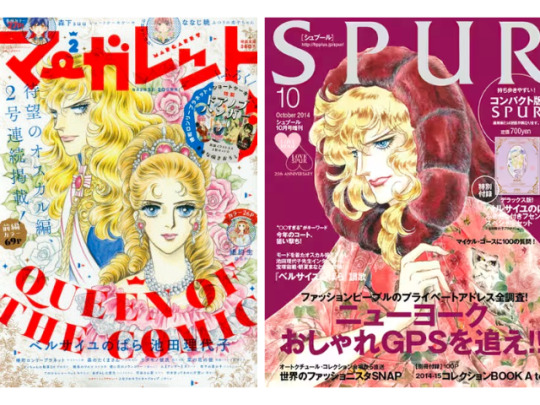
On the left, Lady Oscar and Marie Antoinette adorn the cover of Margaret in 2016, over 40 years after the end of the original serialization. On the right, Oscar models Dolce & Gabanna new collection for high-end fashion magazine Spur in 2014, celebrating 40 years of the conclusion of the original manga.
Back then, Kanebo, the second biggest local cosmetic company, was in fierce competition with Shiseido. TV ads from both companies had a tremendous impact, propelling singles to the top of the charts, and there was a battle on which commercial would feature the biggest hit. But, in the spring of 79, the focus of the fight changed. As a response to the Catriona "Rose of Versailles" campaign, Kanebo also hired a British beauty, actress Olivia Hussey, and launched a "Super Rose lipstick" with the tagline "You are more beautiful than a rose." The cosmetics war was another proof of the chokehold "The Rose of Versailles" had in the decade.
But when the movie finally premiered, it was a flop. Critics hated it, and Japanese fans thought the adaptation was weak and lacked impact. Catriona, in particular, was criticized for not conveying Oscar's androgynous charm, which perfectly balanced masculinity and femininity. With the well-received anime premiering just a few months later, the expensive movie adaptation ended up being outshone and forgotten. It became only a costly footnote in the manga's history.
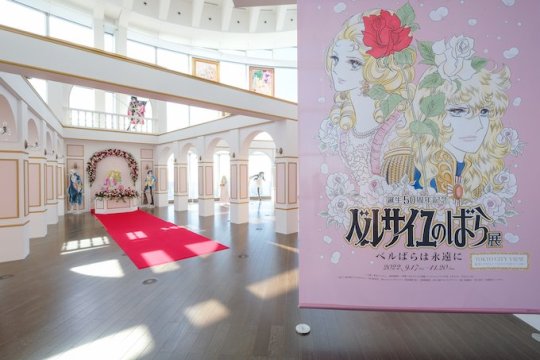
An exhibition in Tokyo celebrates 50 years of BeruBara in 2022.
(It's worth noting that Kanebo clearly won the CM war. While the Shiseido co-produced "Rose of Versaille" feature film flopped, the "You Are More Beautiful than a Rose" song Kanebo commissioned from singer Akira Fuse became a considerable hit).
Movie aside, "The Rose of Versailles" is one of Japan's most beloved comics. From its debut in 1971 to its film and anime adaptation in 1979, it remained front and center in the country's mind throughout the whole decade. Its impact was felt in different fields, from the cosmetic business to the publishing business, from live theater to TV. It also forever changed how shoujo manga was perceived and remains one of the country's most beloved properties.
Ace-Scoring Manga
The 1970s marked a turning point for shoujo manga, as it began to gain recognition beyond its traditional audience, propelled not just by critical acclaim but by commercial success. The era witnessed the emergence of several blockbusters that captured the public's imagination. Notable among them were Yoko Shoji's "Seito Shokun," a tale centered on the daily exploits of a mischievous high-schooler, and Waki Yamato's "Haikara-san ga Tooru," a love story set in the Meiji period featuring a tomboy with a lady-like demeanor. These manga were significant hits during their publication in Kodansha's Shoujo Friends, becoming best-selling titles with tens of millions of copies sold.
Some shoujo classics from the '70s are still in publication today, appealing to a diverse readership spanning multiple generations. Suzue Michi's "Glass Mask," serialized in Hana to Yume since 1976, remains a cultural phenomenon with 49 tankobon volumes, over 55 million copies sold, an anime adaptation, a live-action drama, and a stage play. Similarly, Chieko Hosokawa's "Crest of the Royal Family," chronicling the adventures of a young American girl transported to ancient Egypt, has been a consistent presence in Princess magazine since 1976, boasting 69 volumes and over 45 million copies sold to date.
But, when talking about definitive shoujo classics from the '70s, titles that were historical successes, influenced everything going forward, and are known by everyone, three titles come to mind. We already explored one of these, "The Rose of Versailles." One of the other three is "Ace wo Nerae."

Following the monumental success of "Attack No. 1," the prospects of another shoujo sports manga achieving similar heights of popularity seemed improbable. However, Weekly Margaret defied expectations once more in 1973 with the release of Suzumika Yamamoto's "Ace wo Nerae" ("Aim for the Ace"), a compelling narrative focused on tennis that swiftly captured the nation's attention.
Japan and tennis already had some prior history. The first Japanese Olympic medalist was a tennis player, Ichy Kumagae, in 1920. Emperor Akihito met his commoner wife, Michiko, at a tennis match, and they initially bonded over their love for the sport. But, in the 70s, the country was taken over by an unprecedented tennis boom. At high schools across the nation, tennis became the most popular after-school activity. Fashion magazines like JJ and Popeye dedicated pages and pages to "tennis fashion." At the same time, trendy young adults decked in clothes from sports brands populated Shibuya and other stylish districts in Tokyo.
There were several contributors to the tennis boom. But the remarkable success of "Ace wo Nerae," which first conquered girls before dominating the nation, played a part in it.
The manga follows the journey of Hiromi Oka, a high school student initially plagued by insecurities but propelled into the world of tennis through the encouragement of her coach. "Ace wo Nerae" portrays her growth from a hesitant newcomer to a world-class tennis player, navigating challenges and discovering hidden potential along the way.

From left to right: Madame Butterfly, lead character Hiromi Oka and coach Jin Murakata as depicted in the anime. Madame Butterfly, a wealthy teen girl who is gentle and a world-class tennis player, is a fan favorite character.
In 1973, "Ace wo Nerae" was adapted into an anime. Despite initial modest ratings, the anime gained popularity through reruns. Encouraged by this, NTV decided to remake the cartoon. The second adaptation, which debuted in 1978, was an immediate hit. Concurrently, Weekly Margaret revived the manga series, which, after being first finalized in 1975, ran again from 1978 to 1980, spanning a total of 18 volumes.
Since "Ace wo Nerae," several hit mangas focused on tennis -- both shoujo and shonen -- were published. But, thanks to the success of its anime and the intragenerational support for the manga, the original work by Suzumika Yamamoto is still considered one of the defining and most beloved works about the sport. Its role in propelling tennis culture as part of the oshare youth culture of the '70s also defines its impact.
Japan Wants Candy
Following the monumental multimedia success of "The Rose of Versailles" and "Ace wo Nerae," the third shoujo sensation of the '70s is "Candy Candy."
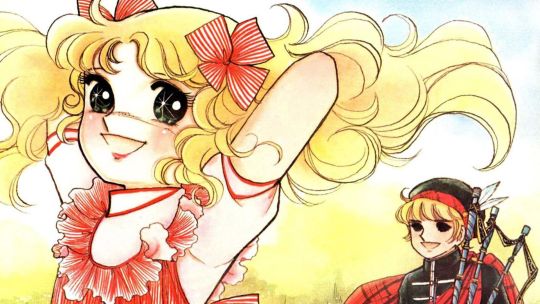
Initially published in Nakayoshi, the story started taking shape when editors at the magazine sought a work of literary excellence akin to beloved classics popular among girls, like "Heidi" and "Anne of Green Gables." They enlisted Keiko Nagita, writing under the pen name Kyoko Mizuki, and paired her with one of the magazine's most famous artists, Yumiko Igarashi. The collaborative effort resulted in the creation of "Candy Candy," centered around an American, blond, blue-eyed orphan named Candice "Candy" White Ardlay.
"Candy Candy" epitomized various shoujo directions prevalent in the '70s. The protagonist, a white girl with lustrous blonde hair, embodied the fascination with Western culture during a time when Japanese youth held a keen interest in Europe and the United States. The manga's narrative style, characterized by its dramatic tone and plot twists, also aligned with the prevalent storytelling preferences of the era.
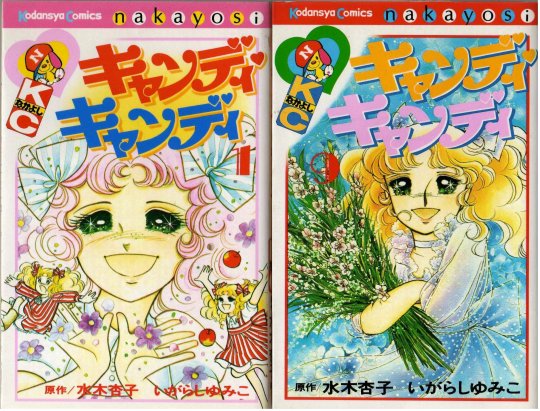
Candy Candy was such a resounding success that it became the first manga to achieve an initial print run of over 1 million copies of one of its paperback compilations.
Debuting in 1975, "Candy Candy" swiftly captured the hearts of Nakayoshi's readers, leading to unprecedented success. The subsequent anime adaptation by Toei in the following year propelled the franchise into the realm of a cultural phenomenon, sending manga tankobon sales skyrocketing. The seventh volume of the "Candy Candy" compiled paperback reportedly became the first Japanese manga to achieve an initial print run of over 1 million copies. Additionally, Nakayoshi's sales surged, surpassing those of its historical rival, Shueisha's Ribon, for the first (and only) time.
The adventures of young Candy were also licensing gold. With over 100 licensed products, the "Candy Candy" doll alone sold 2 million units, solidifying Bandai's position as Japan's premier toymaker, a status it continues to uphold to this day. The resounding success of "Candy Candy" forged a lasting alliance between Kodansha's Nakayoshi, Toei Animation, and toymaker Bandai, which led to the iconic "Sailor Moon" franchise in the 1990s.
While "Candy Candy" concluded its run in 1979, its appeal extended far beyond its original target demographic of very young girls, captivating kids, teenagers, and adults alike, thus contributing significantly to the manga and anime's widespread acclaim and enduring popularity.
However, a protracted legal dispute between Igarashi and Nagita has prevented the commercialization of any "Candy Candy" related products since the late 1990s, including reprints of the manga and re-broadcasting of the anime. The lawsuit arose from Igarashi's unauthorized licensing of merchandise based on the franchise, falsely asserting sole ownership of the copyright. Although Igarashi was initially credited as the lead artist in Nakayoshi during the manga's publication, the court ultimately ruled in Nagita's favor, emphasizing that Igarashi's artistic foundation was built upon Nagita's written work.
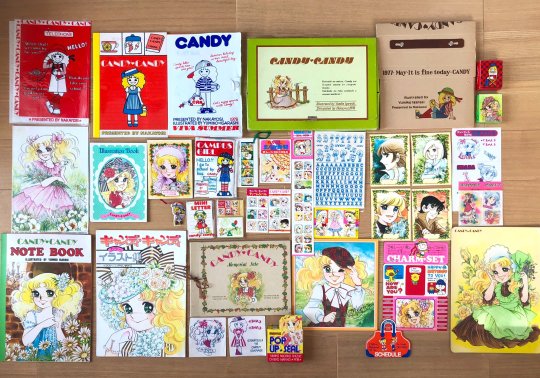
A collection of "Candy Candy" freebies offered by Nakayoshi magazine in the '70s. During the publication of the series, Nakayoshi would eclipse Ribon's sales for the one and only time in its history, (image credit)
Consequently, any commercial exploitation of Yumiko Igarashi's "Candy Candy" artwork necessitates the approval of both Igarashi and Nagita, a challenging prospect given the existing feud. Nagita, on the other hand, can profit from "Candy Candy" as long as she doesn't include any illustrations, which allowed her to release a book sequel in 2010. However, due to the dispute, one of the most beloved works in Japanese manga history is currently out of print. The lawsuit also blocks the anime from being aired or distributed. But, despite the almost two-decades-long media ban, "Candy Candy" remains widely known and beloved across Japan, a testament to its staying power.
While smash hits like "Candy Candy," "Ace wo Nerae," "Rose of Versailles," "Seito Shokun," "Hikara-san ga Tooru," and "Glass Mask," among others were key pieces into shoujo finally earning the respect it deserved, the rise of a revolutionary group of artists during the '70s was another critical element in shoujo's rise: the Year of 24 Group.
Part 2
#1970s japan#1970s#vintage shoujo#shoujo manga#lady oscar#rose of versailles#ace wo nerae#candy candy
114 notes
·
View notes
Note
Have you ever read/watched My Hero Academia? Your thoughts are always fascinating about things like danganronpa+raincode and you've made me appreciate characters much more than I ever thought I could (Junko and Miu specifically being mentioned here)
You like the Haruhi Show, you like danganronpa, MHA feels right in your niche
So it seems kind of up your alley, and I'd love to hear your thoughts on it
I don't really know a lot about MHA, but what I've heard about it is that it's a pretty typical battle shonen. It has several cool female characters with interesting abilities, who are mainly there to be waifu bait; They never get to participate in fights or be central to the plot because boy show boy show.
I don't know how true that is. It's just what I've heard through pop culture osmosis.
I have a couple of those in my fandom library from my teenage years. Dragon Ball, of course. Yu Yu Hakusho. Probably a couple others that don't come to mind off the top of my head. I was aggressively trying to present masculinity in everything I watched and did for a while as a teen, and I now have grandfathered-in investment in those characters even as my tastes have changed.
If I were watching Dragon Ball Z for the very first time today, I'd probably give it a miss.
But these days, I tend to find myself more interested in things like The Apothecary Diaries, Raven of the Inner Palace, or Frieren: Beyond Journey's End. Shows which center cool, interesting women as a driving force in their plot.
Haruhi has a male protagonist, but it also fits that bill. Danganronpa similarly often saddles you with a bland male Projection Bait protag but features a ton of interesting male and female characters who drive the narrative.
To get invested in MHA, I'd need to be confident that the women of MHA aren't just cute and quirky decorations to cheer on the boys who are doing all the cool stuff.
12 notes
·
View notes
Note
The bottom/top debate is tiring because as someone who’s not all that interested the sexual aspect of sns’s relationship (not saying others can enjoy that aspect, it’s just not for me.) I just wanna read about them and their relationship without people using their top/bottom bias to characterize naruto and sasuke.
It’s so prevalent as well, much more than I think people recognize.
That’s why I like your account, you don’t fit naruto and sasuke into these little stereotypical boxes.
Yeah I like to talk about their craziness the most. The writing, the mirroring, the development, the contrasts... how perfectly they fit together.
Anyone notice how this happens in every single fandom? People mischaracterizing characters for a ship? Het shippers do this as well, but if we talk about fujoshis, they often pick like, one character that is woobified and made to be lusted after by all the other male characters. Often this is the main character of a shonen series, Like Naruto or Deku. Or most recently, Yuji. It's kind of comical for me to look at a character who so far is so straight like Yuji to be made into this whimpy uke that all the guys fuck lol.
While Naruto is gay, Kishimoto's characterization of him is so far from what certain people wished it to be. He's a mess, he's not feminine, not girly, not polished, not frail and certainly not a doormat whimp. Kishimoto said he wanted Naruto to be like a typical messy and mischievous boy. Near the end of the story, he said he wanted to draw Naruto as more mature and cool. He also put a lot of his own personality traits into him. It's like people either just don't know how to read or they just don't care. Naruto is his own character, not a vessel for people to project onto. Why don't people care about the actual character and his actual story? To me they aren't different from SS who also don't care about the characterization of Sakura and Sasuke, they just like how they look together.
I haven't read fics in a while because I just can't get into them usually, but I really wish people didn't fucking focus on dick size during a sex scene so much... it is not crucial during butt sex, the size of the dick. And not all sex requires penetration to begin with. But most of them are written by straight women so I guess it's to be expected.
59 notes
·
View notes
Note
"Sorry to the gays but only a straight man could create Gojo and Toji"
"Nah JJK men could only come from the subconscious of a straight guy who wants to look cool and kick ass like his squad of himbos"
The above what I found in twitter, what do you think?
Sounds dumb and like projection. There was a reason why people thought that Gege Akutami was a woman before a man with a mechamaru mask did an interview.
Gojo and Toji are typical shonen characters. You just need to be a fan of shonen titles (like Yuyu Hakusho, Hunter x Hunter and Bleach) to create characters like them. You also need skill to make a character like Gojo work.
When you look at the femininity present all over JJK though, then you might wonder if that man under the mechamaru mask wasn't just a stand-in for a female mangaka.
Geto for example, is written with ample feminine traits including being depicted in the image of a goddess once. The deuteragonist has a girl's name. Kenjaku might turn out to be originally a female villain on top of being the protagonist's mother and the importance and the themes of the "womb" is ever-present in the narrative.
Someone once said that Chainsaw Man is the manga for horny men and that Jujutsu Kaisen is the manga for horny women. Would need people who read CSM to comment on that.
Even if Gege really is a straight man, that guy is obviously in touch with his feminine side and isn't afraid to write it down. People who say things like the above are hyperfocusing on a few aspects of the manga that they like while turning a blind eye to the rest.
24 notes
·
View notes
Text
Some thoughts on Bucchigiri?!
As I write this, Bucchigiri?! is about to release its last episode

Arajin from Bucchigiri?!
First things first. I have a weird feeling about the cultural appropriation of stereotypical arab "aesthetics" thing here. But it's a complex matter that I'm not addressing now, I have to educate myself more to talk properly about it. Though, as I've seen other people say, it seems Utsumi is following the original plot of 1001 Nights and I think I understand why she chose it. The original Aladdim is a horrible person, the perfect matrix for a selfish, coward and irritating Arajin - a main character who is the opposite of the shonen hero trope. Almost as hated as Shinji Ikari from Evangelion - a much older and bigger project. By the way, I see some references to Evangelion and other classical anime across Utsumi's works and this is something I would like to address in the future.
Another topic is that I had already noticed with Sk8 the Infinity how interesting Utsumi's approach on masculinity is, especially queer masculinity. No wonder a considerable part of the sk8 fanbase is masc-oriented, either trans men or non-binary people. Now, with Bucchigiri?!, masculinity seems to be the central topic of the work. I wanna write more about it in a future post. Please mind that I don't take too much into consideration protocol, evasive answers in interviews. Rather, I prefer to study the author's work, worldbuilding, plot and characters, using interviews only as a side consultation sometimes. I'm not immune to misunderstandings and confirmation bias, though, so take my analyses with a grain of salt.
This post started to get too long, so I decided to break it into a series of shorter texts. I intend to update this main post with the links to the other ones (if I happen to have time and energy to write them). Mind that I'm not doing extensive research. It's just a collection of thoughts that may or may not make sense. For me, well posed questions are more interesting than categorical and definitive answers.
Mahoro as all women
Sk8 the Infinity: a beef parallel
Katabasis and tragedy in Bucchigiri?!
Masculinity as a central topic of Utsumi's works
15 notes
·
View notes
Text
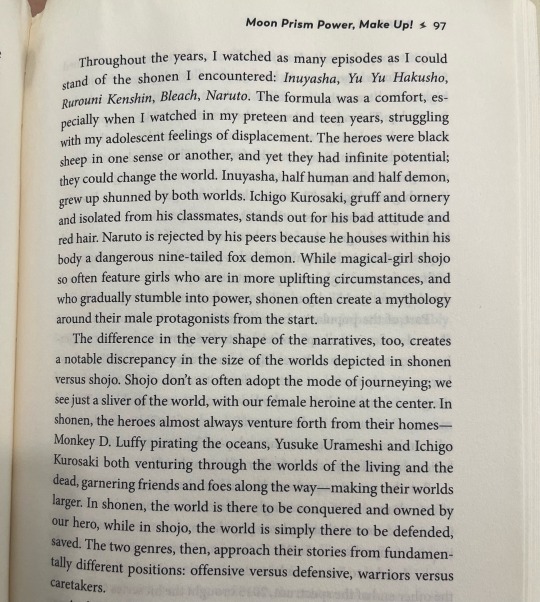
From Nerd Adventures in Fandom From This Universe to the Multiverse by Maya Phillips. Interesting how the gender divide of “outward bound explorer taking on the unknown world” and “nurturing guardian of a domestic sphere” still makes itself present, even in children’s escapist fantasy.
5 notes
·
View notes
Text
Haruno Sakura and misogynistic ass fandom
sakura haruno is one of the most hated chareters in naruto with her hate being so comically massive that it surprised the creator himself... but why ? what went wrong with sakura ?
I, in particular ,am not a fan of the way kishimoto wrote women in the manga or how shonen in general potrays female charechters. But the thing with sakura and misogyny is that it has more to do with the fandom than the author ,and if you ask me ,compared to how demented the fandom is ,kishimoto practically looks like a feminist icon . character criticisms dont bother me, but in the curious case of sakura alot of this “criticism” spirals down to very abbhorent misogyny.
starting right of the bat we have the dude-bros and self-projecting psycho's of the fandom, who hate her cause she's a shallow bitch(their main male charecter-onto whom they project- is a serial attention seeker btw , with being popular his main incentive in life) who likes the popular , good-looking guy and doesnt pay heed to the nice guy's advances dattebayo , no kidding -
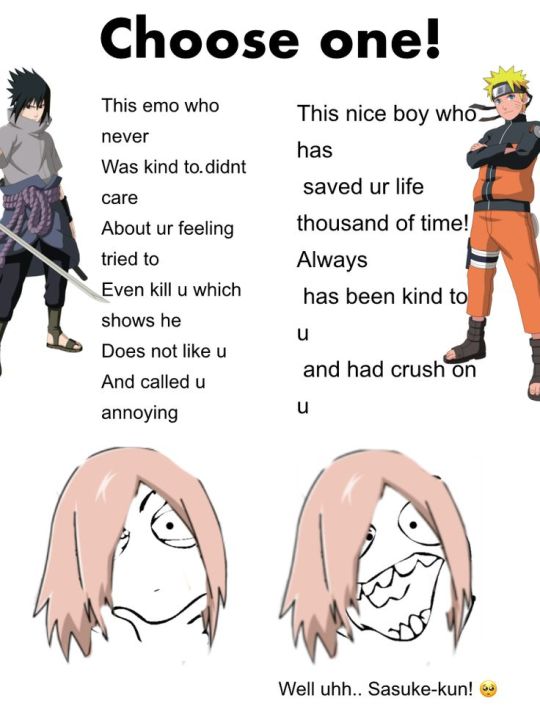
i found it difficult to wrap my head around how this utterly gross misogynistic nonsense is so fucking common , it seems that sakura might have triggered their deep down incel by daring to want sasuke -and this also happens to be the reason why hinata is so popular amongst that particular crowd -because unlike that shallow bitch who rejected our nice guy, hinata worshiped his tiny err.."naru-chan"
these wankers' try to paint hinata as the submissive waifu prototype (erasing even her little canon qualitites we get to see to fulfil there deraged fantasies) and just to cope with the fact that sakura rejected naruto , but err he got the plastic doll waifu , so all is well. they dont end it here though , they go on to elaborate how miserable and sad sakura's life and is that this is what she deserves for "choosing the emo" over the nice guy , while naruto apparently had a better ending for himself by "scoring" hinata .
it reminds me of this apallingly misogynistic meme-

you'll hope these deraged psychos end here , but they dont.
the next slandering is surprise! surprise! -sakura's looks
because y'know naruto just had some dirt in his eye when he calls sakura cute. or even when making a remark on how incredibly beautiful haku is, sakura is the objective female beauty standard he compares him to, and the true hidden beauty in the series is hinata imao(the one whose been called weird, plain and crumpy throughout canon) or the inferiority at sakura's rejection and sasuke's obvious superiority to naruto is curbed by hyping up naruto's own looks saying (based on anime filler nonsense) that naruto "gets princess" and sasuke gets normal girls , while throughout the manga the only girl that shows any sort of romantic/sexual interest in naruto -is hinata (and the reason why she likes naruto has little to do w looks) , thats it , even when he becomes the messiah of the hidden village by making pain revive everyone-no girl is interested in him (I adore Kishimoto for doing this and not sticking to the sexist bs of these shallow bitches like our underdog nice guy only when he become popular GRR..GRR.., except for princess byakugan ofc- thennnn lo and behold ,studio peirriot uses this misogynist ass trope in "naruto:the last" , there is only a limit to keep rejecting you deranged fanbase i guess, sometimes one must comply for money)
these petty dumbsos dont even stop here, you though misogyny was enough? what about misogyny+sexualisation(of an UNDERAGE character) +body shaming ?
since sakura has commited the blashphemy of daring to reject naruto's advances (did you hear the recent news of a black woman getting hospitalized after she rejected a dude, becasue that turd was so pissed at her audacity that he threw a brick on her face or that gory case of junko furuta,may her soul be in peace,which is so sick i dont even want to delve into it), , dude-bros have to , no, NEED TO find ways to get back at her , uh? u rejected naruto? HAHAAH bish u flat
psychos , female charechters exist for girls to feel represented and not to serve as cumdumps for your repulsive incel mastrubatory fetishes.
sakura's own fandom has failed her in this regard with the net being bomabarded with sakura wankers' trying to prove their queen isnt flat, sizing her bosom from multiple angels across multiple panels so that she can finally fulfil her long impending destiny of actualizing the incel cumdump fetish
what is also curious is kishimoto doesnt comment anything on sakura's chest throughout the manga -he does add a panel of naruto's smol pp,and how naruto is insecure about it -NO one in canon says anything about anyone's bosom (excpet that creep jiraiya, but even he spares underage girls) and sakura almost never mentions any insecurity related to her boob size , she is insecure that she has big forehead, she is (perhaps) insecure about her weight that is why she skips her meal. heck even sai the roaster toaster with awfullly bad social boundries doesnt comment on it, but guess what? the fandom and SP does infact SP made a fucking full filler episode which is just sakura wanting big boobs and the comparisons of boobs from various koinichi's ranging from Tsunade, to tenten and ino, to shizune!)
why is this "boob measuring" so unique to sakura(and hinata -ill perhaps make a post on this sometime) why is no other female charecter subjected to this gross misogyny weird boob measuring contest,despite sakura not being the only girl who is flat chested- Tenten , Mikoto Uchiha and Shizune? well for one none of them has outright any interactions on level with naruto , second they dont irk anyone is any way - mikoto is also reduced to the trad sub wife prototype(she is what you'd say harmless, unlike the boisterous sakura, she is soft spoken , tends for the males areound her and doesn't err stand out), tenten and shizune are not even present in the narrative often and when they are , their words wrt to naruto are "safe" - they dont insult the main character , dont reject him dont make him look inferior so their boobs and body are spared
OH! just found another gem

incase you are unable to read it properly
-Rin is confessing to kakashi
-and half crushed obito is saying "wow bitch"
Yeah Rin !! how tf can you do that! imagine a 12 y/o confessing to her crush before she commits suicide for the "greater good" of her village , OMG !! you're such a bitch how dare you like else someone when my self-projection has a crush on you !!!! the gal!! the the audacity !!my virgin tradwife hinata so much better fr fr
31 notes
·
View notes
Note
am i the only one who's really dismayed with anime in recent years? the vast majority of things we get are either high profile shonen/seinen manga adaptations (which are basically advertisements to visit the source material if you can't be satisfied waiting a year+ to know what happens next), flash-in-the-pan lightnovel/webcomic adaptations (mostly isekai), and coomer shit. there are very few series for women, girls, and any other demographic left unsatisfied by high-profile shonen/seinen.
once in a blue moon we get a fruits basket remake type event, but most of the romance genre nowadays is a glut of coomer shit that'll be forgotten after the season ends because tits and ass is always the same and forgettable after the post nut clarity sets in and it's the goddamn story that stays with people years down the line. even the BL girlies have either moved on to china and korea for content or became manga-onlys. so few of the good stuff gets adapted, and original anime is seen as an unnecessary financial risk. at this point, i'm far more interested in manga for the wide variety and great stories available, and old anime.
i haven't seen enough anime especially newer ones so maybe my opinion doesn't hold merit BUT i agree. especially with the lack of content for any demographic that isn't young men. The state of the anime industry in japan is so dire and has been so for years now, like atp i wish they would unionize and go on strike to demand better working conditions + higher wages; the amount of labour and creativity and skill they put in for what is ultimately minimal payoff is just cruel, absurd and criminal. The industry is only focused on boosting IP for merchandising and it's a sad state of affairs. They did the same thing in the 70s to disney and wb animators where they were worked to the bone for one meddling project to another and were ultimately driven out of the craft. Animation is thankless work and i feel the artists and animators deserve a chance to create artistically fulfilling projects instead of drawing inbred looking anime waifus for what seems to be an insatiable, miserable audience.
33 notes
·
View notes
Text
Summary: A canon divergent fic where the Hatakes were born women; this work examines how this change would affect the canonverse and how the characters are shaped by the people and gender expectations around them.
Author: darkseraphina
Note from submitter: The only genderbend fic you will ever need, I mean it. I'm not into the Naruto fandom much but it is so goddamn hard to find any good female focused works in shonen I applaud the author for trying (and succeeding) to give them the proper spotlight. I know people call genderbend lazy and unimaginative but it's actually so good. There's actual thought put into the inherent misogyny of the Narutoverse. Sakumo's relantionship with Kakashi is amazingly written, Jiraiya doesn't suck monkey balls, it's sex positive and there's heaps of found family in this. Also if you're afraid this just has canon male characters and no one else, Tsunade and Mikoto both have pretty big roles in the work. Rin doesn't get fridged and get the proper respect she deserves, which is always nice.
#official fic poll#haveyoureadthisfic#pollblr#tumblr polls#fanfiction#fandom poll#fanfic#fandom culture#internet culture#A Woman's Honour; A Kunoichi's Heart#naruto#no romantic relationships#authorless#ao3
9 notes
·
View notes
Note
Re: shonen-and-shoujo as someone who is hoping to write her own girl shonen someday: It is nice to see some more thoughtful additions to the shonen v magical girl thing! Thanks for breaking it down in that post.
Though I do have a point to kind of add to the convo: I think a part of the reason why I was more eager to suggest magical girl stuff to people who wanted a shonen but with girls *was* because a point I had heard a few times from a couple of people was how they disliked that female characters in shonen had to “act like men” in order to be strong. Which was where my point of confusion came from.
People who say they want a girl shonen that specifically has more tomboyish characters makes a lot more intuitive sense to me, and it will be what I aim for in my project. But I think that might be one reason why some people do instinctively rec magical girl stuff.
To be frank, I’m not fond of the dismissiveness around female characters who “act like men” in these circles. Like, I am a woman who can be classified as pretty feminine, and I get why people would be annoyed at like, not having the traits they typically inhabit be framed as strong. But on the other hand, like, media rep for masculine women is also pretty sparse. And at least for femme girls, we do have something close to that. (Also tbh a lot of women in shonen aren’t even masculine).
(Tangential thought, but it is worth noting that a lot of currently existing media which could be classified as girl shonen does feature feminine girls. I think Soul Eater is the big example.)
Anyways, apologies for rambling. This is something I have quite a few thoughts on and I had wanted to share them with someone. 😅
Yeah, I agree. A lot of the time there's this idea that female characters are somehow obligated to "act like men"[1] in this kind of media, but if you actually look at it those characters are generally still feminine[2], just strong and willing to fight as well.
I think part of it might just be that a lot of people have such a strict view of gender roles that even that comes off as overly tomboyish to them. That's probably how we get stuff like "the butchest girl twitter can handle before they start getting scared" or that one sad mormon conservative losing his mind over princess Peach wearing pants for a little bit in the Mario movie.
When acceptably gendered behavior is extremely narrow, practically anything (especially anything that would make you all that relevant in a series focused on training and fighting) makes you non-conforming.
[1]: And why gender behavior like this either way? What does "acting like men" even mean when men are not a monolith and women also have a high degree of variance to their personalities and interests?
Personally I think most people have varying combinations of traits considered "masculine" or "feminine" but social expectations and upbringing may force them (sometimes through abusive means) to suppress this variance in order to conform.
So I don't think women, fictional or otherwise, ever really "act like men" because I don't believe "acting like men" is a coherent type of behavior to begin with. Gender roles as a whole are just blatantly fake in my opinion.
[2]: Soul Eater definitely fits as an example of this. It has a lot of really cool female characters, but they still tend to largely abide by the social expectations forced on women. If we translate "acting like men" as being gender non-conforming, then they definitely don't seem to be doing even that to a significant degree.
Like, I love Maka and Tsubaki but if someone called them GNC I'd be kind of concerned for the reasons explained above.
And the same is true of shonen women more generally. A lot of them don't even wear pants. How are we going to scandalize the trads again if they're not wearing pants?
P.S. Read Fate/stay night and the Tsukihime remake coming to Steam soon! They have some nice, properly violent fight scenes that women have very major roles in.
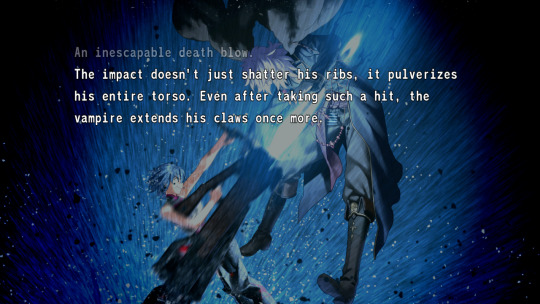
7 notes
·
View notes
Text
The "Favorite Comics I Read in 2023" Roundup
I didn't read as many comics this year as I have in the last couple- partly because I've been a lot busier with university and living in a new country, partly because I've been trying to read more books, and partly because I spent a good few months on a certain behemoth of a comic that'll be taking the #1 spot on this list. At the end of the day, though, I'm an opinionated woman who can't resist doing a retrospective on her favorite reads of the year. There's a few honorable mentions that deserve to be given note, though: Dogsred and The Jojolands are two of my favorite ongoing series right now, and the only reason they aren't making it onto this list is that they're too new for me to have a really solid opinion on beyond "I get excited when the new chapter comes out". I also, somewhat guiltily, want to give a shoutout to Sins of Sinister, which isn't what I'd generally consider a "good" comic, but which went a long way to revitalizing my interest in the X-Men after a decade of not reading X-books, pretty much entirely off the back of the new faggy characterization of Sinister.
Without further ado,
10. Chainsaw Man (Part 2)
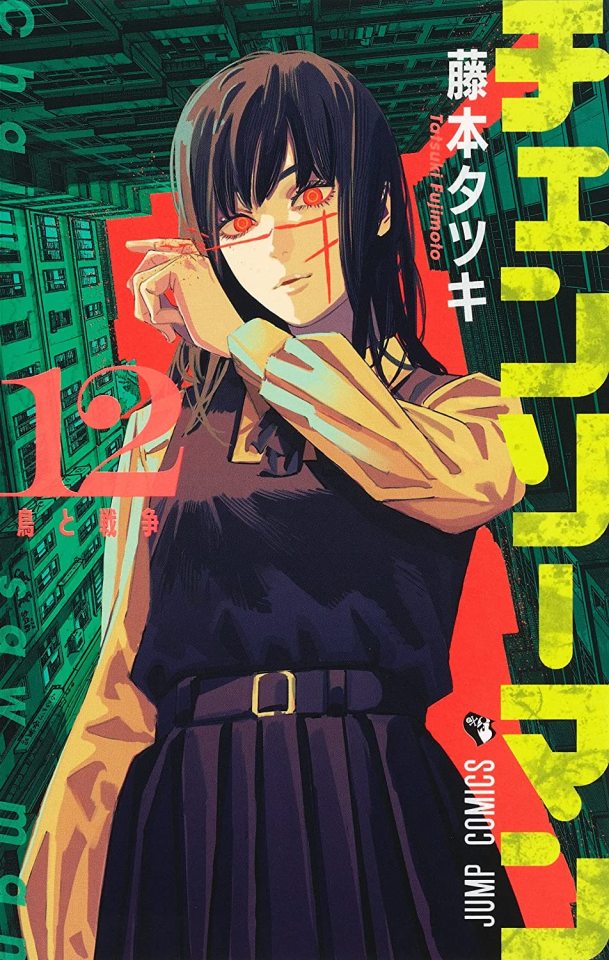
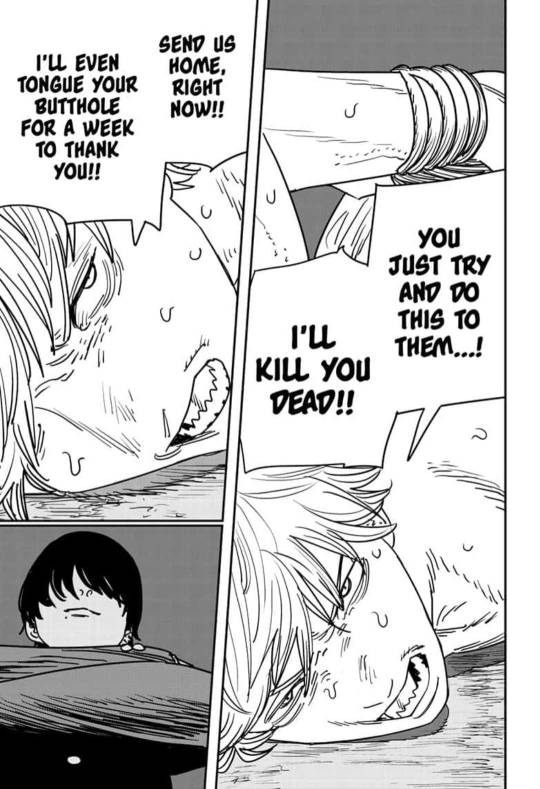
Despite starting the year as probably my favorite ongoing comic, this comes in at #10, with my feelings on it going pretty hot and cold over the course of the year. It struggles with the same erratic pacing that all of Fujimoto's projects seem to encounter, but the highs are very very high- there's a very interesting story being built here in which the idea of normalcy and in particular its relationship to heterosexuality and domesticity are called into question. It still remains to be seen if it'll stick the landing, though, and admittedly I'm not thrilled about the last bunch of chapters. But it's been a fun ride this year.
9. The Joker: The Man Who Stopped Laughing
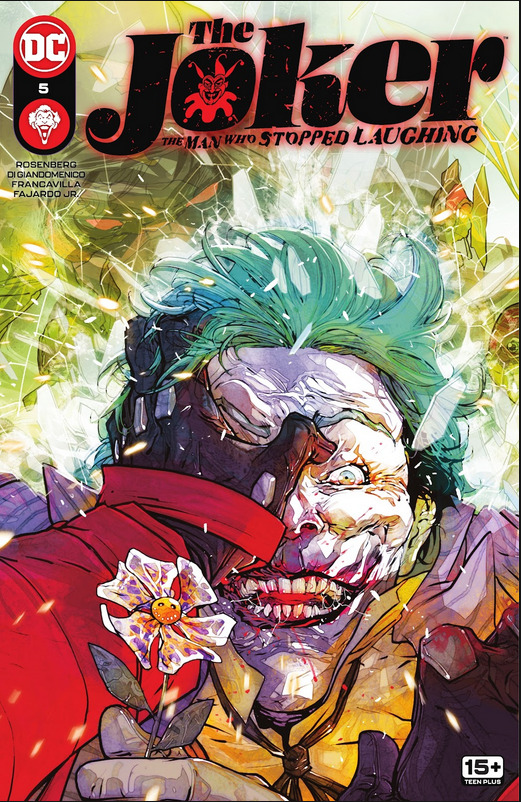
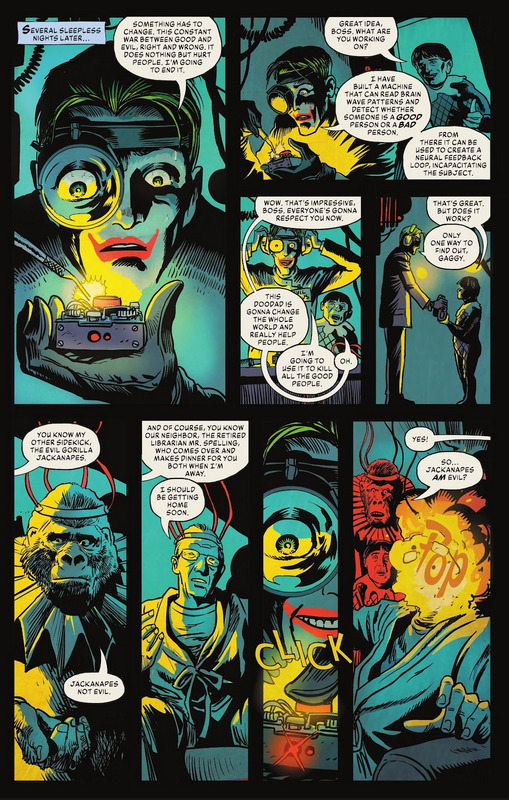
This was the year in which I tried to really get back to familiarizing myself with what the superhero genre has been doing in the last decade, and this was, surprisingly, a standout. It presents the most interesting take on the character that I've read in a long time, turning the "one bad day" narrative on its head by emphasizing the Joker as a character defined by the negation of an originating narrative. The real highlights here, though, are the side stories that accompany each issue, giving great thematic juxtaposition but mostly just being darkly funny shorts in their own right. It does end up hitting a lot of the shortcomings of most superhero comics in 2023, though- there's a subplot with the Red Hood that doesn't contribute as much as it should, an annoying interjection by a crossover event I didn't read.. but looking past that, this was a good one the whole way through.
8. Jojolion
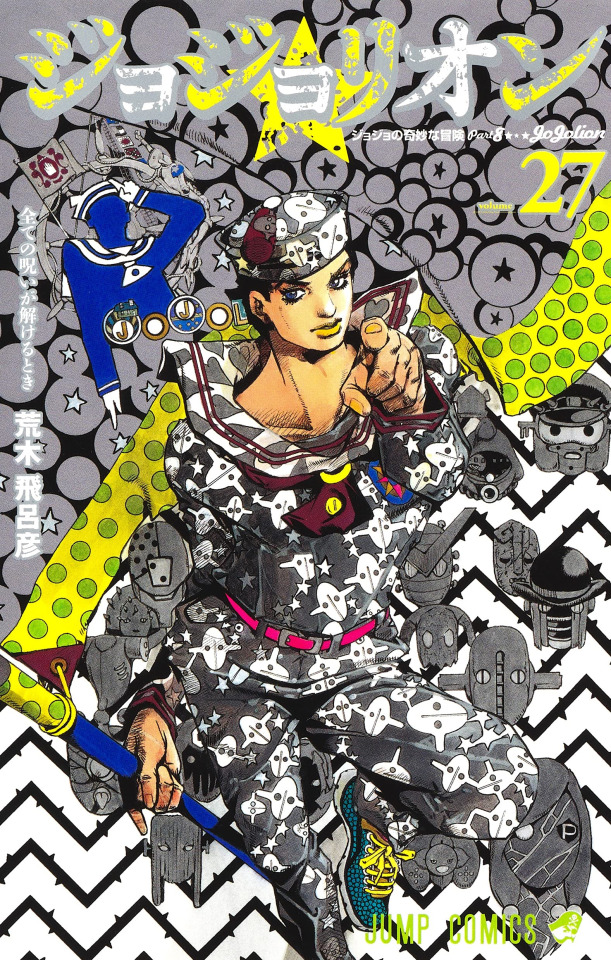
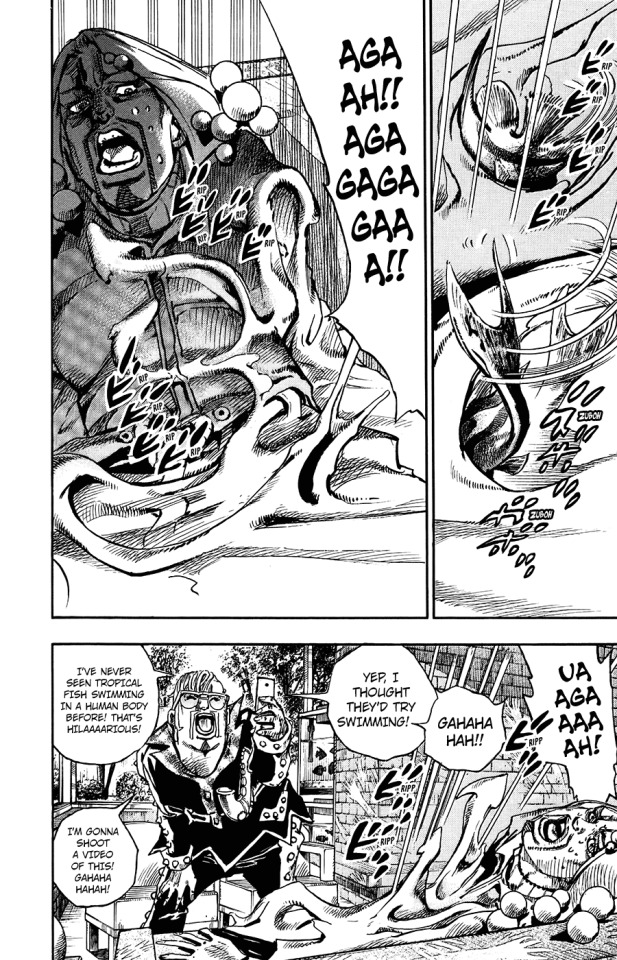
I almost didn't include this because I forgot that I read this all the way back in February! I do feel pretty strongly that this is Araki's most developed work (although Jojolands is shaping up to be a strong challenger)- it breaks away so dramatically from the storytelling conventions that have defined his career, keeping a lot of the superficial elements of a shonen but using them to tell a much more intimate and everyday kind of story. All of this comes through wonderfully in the art, where Araki's trend towards more and more unrealistically beautiful people meets a passion for grotesque violence and painstakingly detailed backgrounds, imbuing the whole work with a wonderful surreal feeling. The comic is governed by a tension between the highly graphic shonen elements and the comparative mundanity of the story around family and personal identity, and it threads that needle in a way that is so perfectly unique to Araki's style.
7. The Pervert
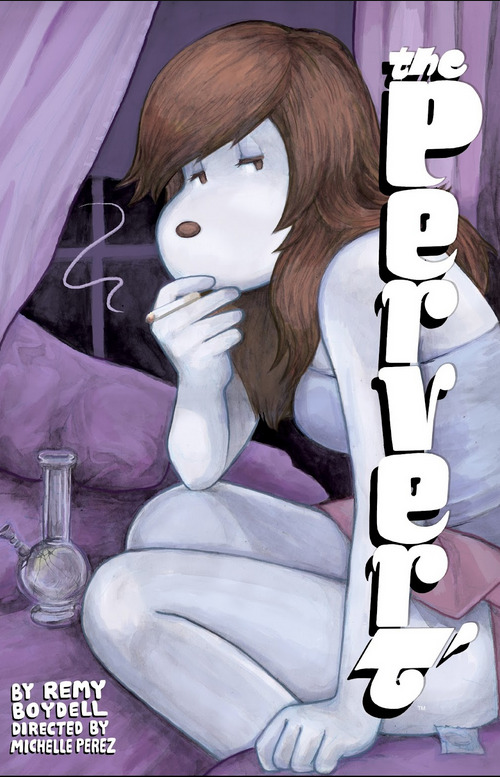
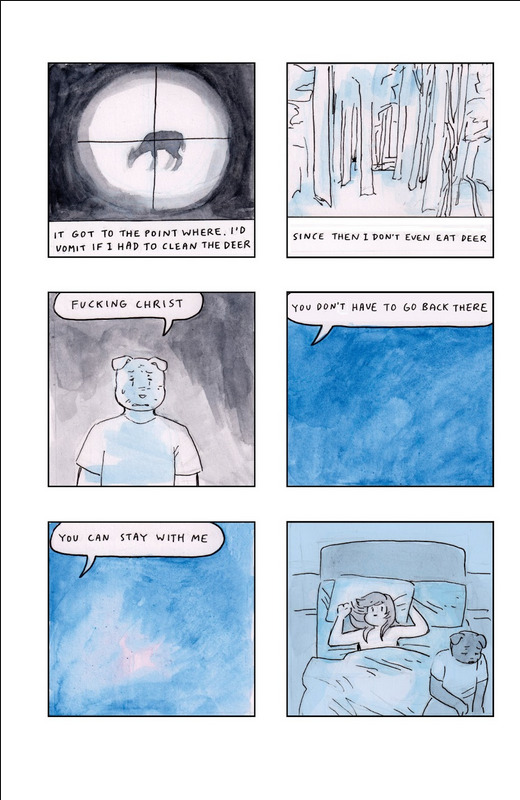
Honestly it's a surprise that it took me this long to read this, given how its become cemented as part of the "depressive trans girl indie" canon. Narratively its a gut-wrenching look at the interplay between isolation and sexuality in trans womens' lives, but what really elevated this for me was the use of very muted watercolors and consistent 2x6 panel grids to imbue the work with intense feelings of loneliness, punctuated by rare moments when the format gives way to these beautiful full-bleed pages. Fantastic stuff.
6. One! Hundred! Demons!

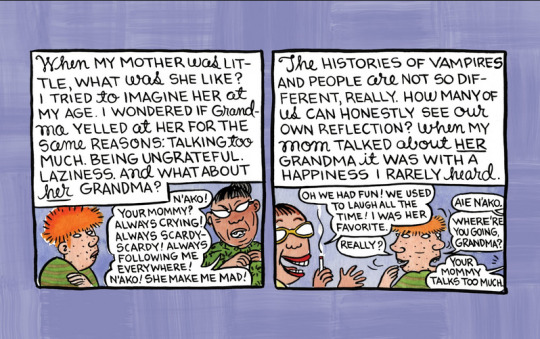
Honestly, I'm a little bit at a loss of what to say about this one: there's just so much going on. Lynda Barry's memoirs do an unbelievably effective job at building the texture of a childhood and adolescence, drawing us into a life that is sometimes very funny and sometimes deeply sad. Barry's unique cartoonish style is used to great effect; juxtaposing the limited worldview with which a child has to process their own experiences against text carrying the reinterpretations of an adult Barry. The whole thing has a very intimate tone, and while that feeling is underscored by Barry asking the reader to consider the precarious relationship between truth and fiction within a memoir; I feel that the admission of her own unreliability only enhances the personal qualities. Absent of the expectation that we are reading a chronicle of events as they happened, the work becomes much more interesting as a way of processing events as they are remembered.
5. Shimeji Simulation
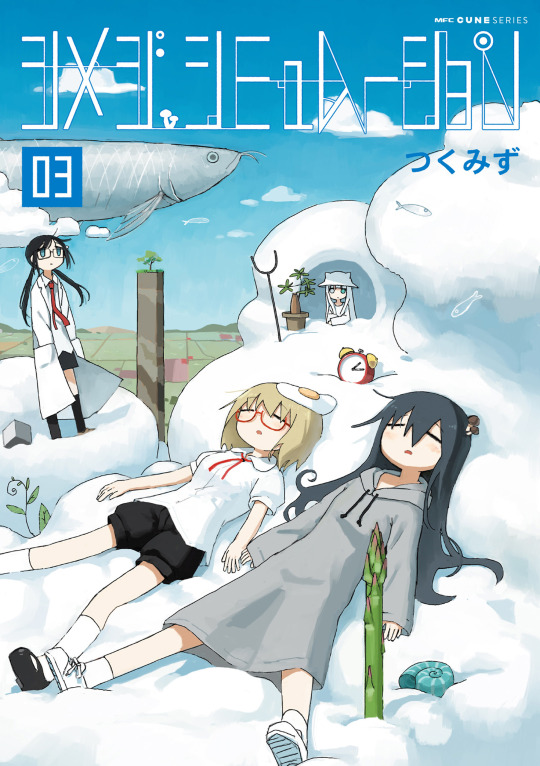
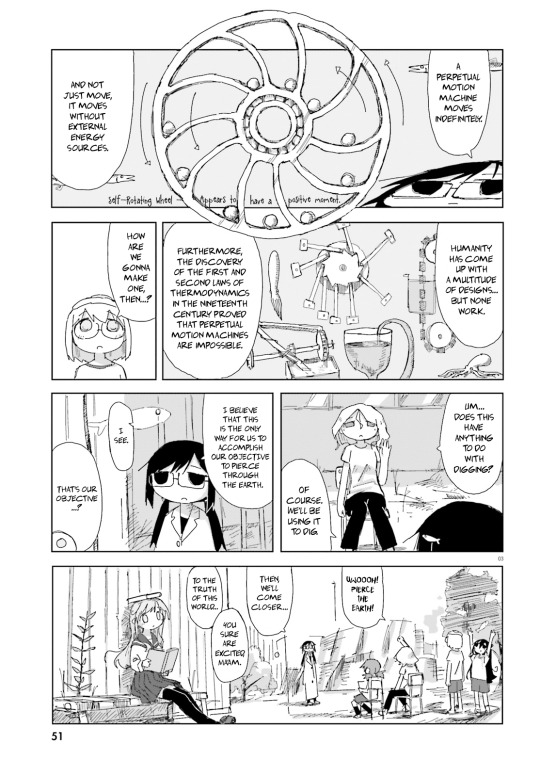
It's a little awkward putting this here because I haven't finished it.. or read it since the summer... but it's such a masterful work. It takes the trappings of the slice of life 4koma in such interesting directions, where the mundanity of the genre and the negation of drama become diegetic forces governing the world. But its not really a story about that- the character of the older sister shows up from time to time to prod at the limits of the genre, but its secondary to the very touching Girls' Love story at the heart of the work. I'd love to say more about the intersection of these threads and how the work deals with the idea of normalcy as it relates to adolescence.. but its hard to give good takes when I haven't finished it! But! I've adored everything I've read so far.
4. Choujin X
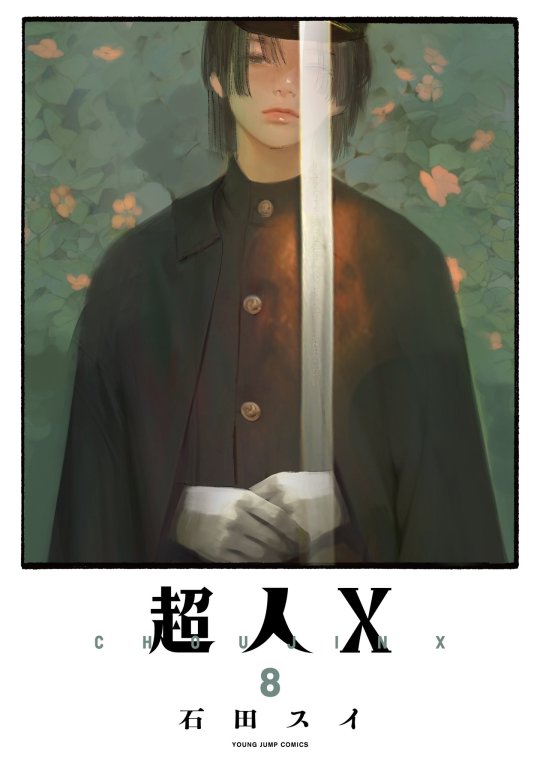

If you wanted to point a finger at why Chainsaw Man is so low on this list, its because I read another ongoing madcap thriller with a ridiculous amount of gore: Sui Ishida's Choujin X. The story, about an organization of super-powered beings tasked with stopping other super-powered beings while trying to avoid being turned into monsters by their own powers, is nothing spectacularly new for the genre; what stands out is instead Ishida's artwork. The combination of sketchy stylized penwork and black and white photography give the series a gorgeous, unique look. And this isn't to say that the story is bad, either: there's a ton of personality to the characters and setting that make it a very very fun and interesting read above anything else.
3. X-Force (and its spinoff, X-Statix)

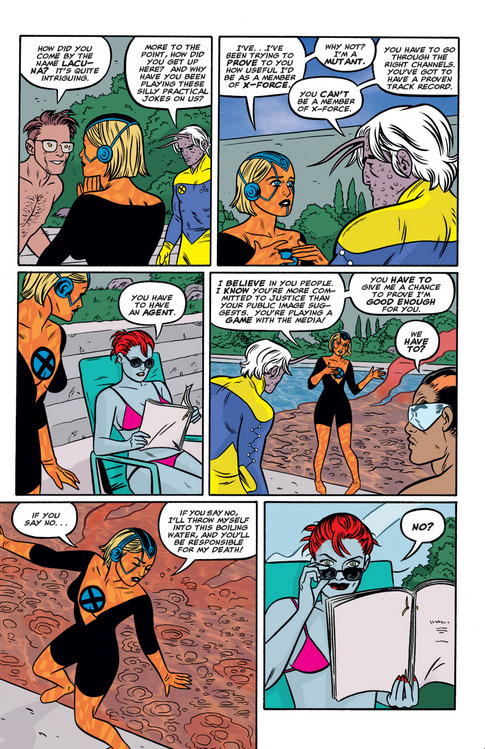
I'm not sure what surprises me more: that this seems to have been lost to the abyss of history, or that I loved this as much as I did. Milligan & Allred's run on X-Force and X-Statix is far from the only take on "what if superheroes were selfish assholes", but something about this really hooked me in a way that nothing like it really has. Maybe its the specific choice to apply early 2000s celebrity culture to the X-Men, maybe its the fact that the asshole superheroes in question still manage to be rich and compelling characters, maybe its the comedy of jumping from Rob Liefeld's "Cable shoots a bunch of guys and grimaces" to Milligan & Allred's neurotic wanna-be celebs with powers, or maybe i just have a really big crush on Dead Girl. One way or another, this has ended up being the standout hit for my sojourn back into superheroes (and its probably telling that my favorite superhero comic is the one that tries very hard to not be a superhero comic).
2. Maka Maka
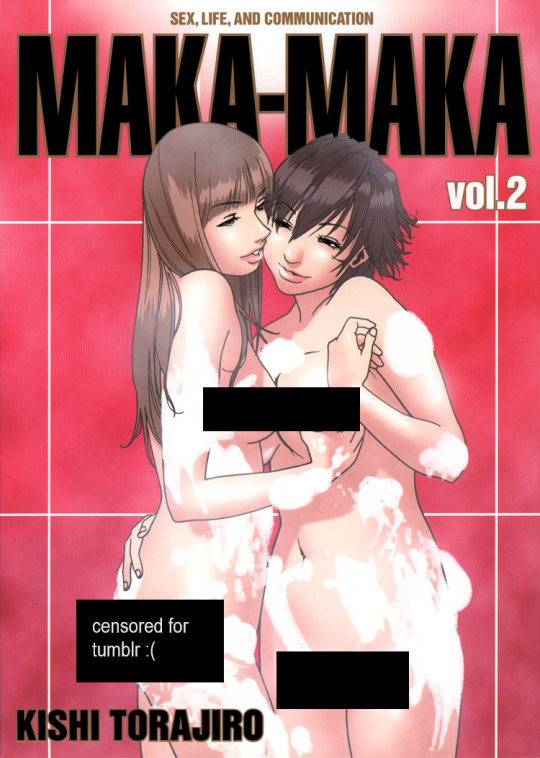
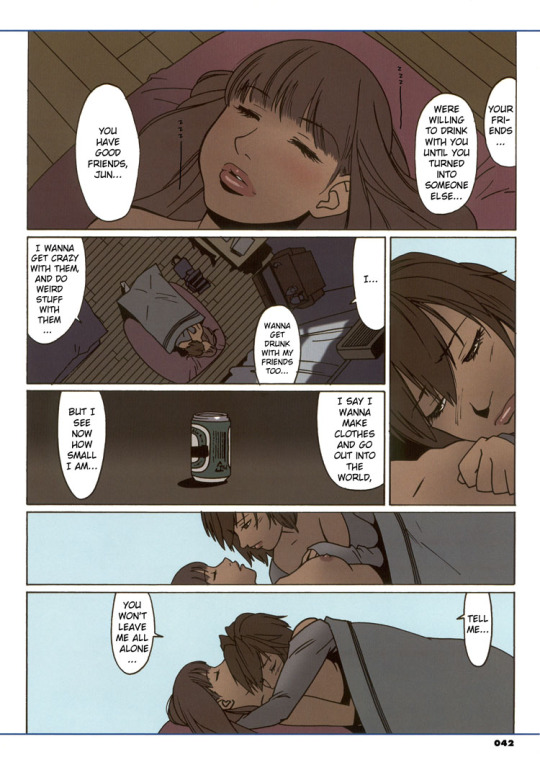
There's an impulse to dismiss this offhand as just being lesbian porn, which it is; but aside from being really hot this manages to be one of the most interesting and endearing explorations of sexuality and intimacy I've read. There's no tension between the porniness and the maturity of the narrative here- its a work focused on the complexities of sex and desire that is just as intent on exploring those themes as it is on giving you something hot to read. Pretty undeniably one of the best girls' love works I've had the pleasure of reading.
1. Homestuck
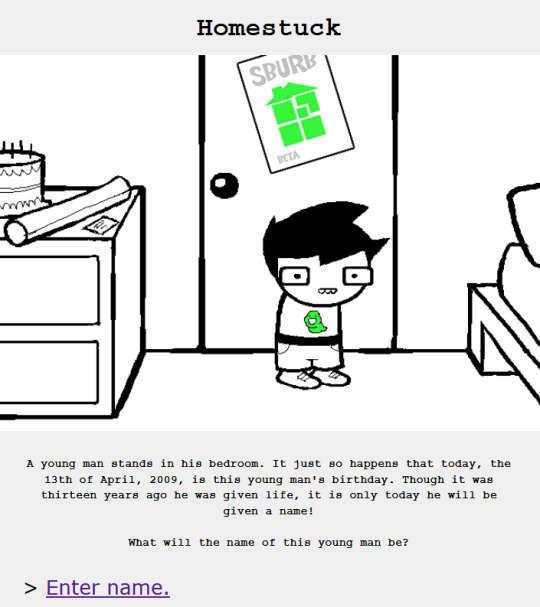
I finally sat down and reread Homestuck this year, having originally read it from late 2014 until its conclusion in 2016, and flirted with rereading it now and then but never really committed, partly because of whatever drama surrounded it in any given year and more emphatically because its really long. But now I feel that I can say very strongly that Homestuck is a masterpiece. Given the scale of the work, there's so much that could be said about it: how it uses the format of a webcomic to its full potential by incorporating minigames, animations, changes to the site, & so on to convey narrative; how it plays with genre in a really interesting way by making genre conventions diegetic (not just with captchalogues &co but with things like Causality acting as a clear narrative thread for the cast to relate to); how effectively it captures being a teenager online at a certain point in time; or just how funny so much of it is. I'm extremely glad I read it this year, partly to be able to have an opinion about Homestuck that isn't informed by my teenage impressions and Tumblr discourse, but more than that because it was an extremely fun journey. At some point I'd like to write something longer about Homestuck and its place in comics because I do think that it is overdue for a reappraisal that is not overshadowed by the fandom.. but until then all I can say is that I loved this more than anything else I've read in a while.
And that's what I liked this year :3 As far as next year goes, I'm very excited to see where Dogsred and The Jojolands go, and I have hope that MamaYuyu could be really great if the writing gets a bit less rote. I've also liked the directions Frieren and Gokurakugai are heading, as well as the new Penguin series thats currently going. Hopefully, 2024 will also be the year that I sit myself down and finally read Berserk, which has been an embarrassing blank spot for me for the past few years. Unfortunately because I'm not on Twitter anymore, I'm less on the pulse of the cool Indies coming down the line, but I'm sure I'll get recommendations for the really good stuff from someone somewhere. And! Maybe if we're really good, Togashi will leave some new Hunter x Hunter chapters under the tree.
8 notes
·
View notes